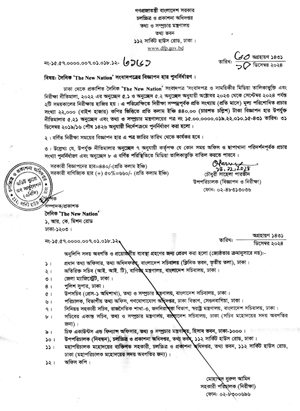Special Correspondent :
The Dhaka Transport Coordination Authority (DTCA) has embarked on an ambitious endeavor to construct the Dhaka Outer Ring Road, a visionary solution aimed at alleviating the relentless traffic gridlock plaguing the bustling metropolis of Dhaka.
Initially envisioned as spanning a distance of 132 kilometers, the project underwent a significant expansion, stretching its length to an impressive 178 kilometers, marking a noteworthy increase of 46 kilometers.
However, with this extension, the financial landscape of the project has undergone a dramatic transformation. What was initially estimated at Tk 15,000 crore has now ballooned to three times that amount.
This surge in expenditure, however, is not solely attributed to the elongation of the road; rather, it is emblematic of the intricate complexities inherent in the construction process.
Interestingly, amidst the escalating costs associated with road construction, there exists a silver lining.
The adoption of a new design, while contributing to the rise in construction expenses, has presented opportunities for mitigating expenditures related to land acquisition and eviction.
The Cabinet Committee on Economic Affairs granted its resolute endorsement to the project in September 2019, paving the way for its realization through a public-private partnership (PPP) framework.
At its core, the project embodies a multifaceted vision, transcending mere infrastructure construction to address systemic challenges afflicting urban mobility.
With a strategic emphasis on curbing through traffic, enhancing radial connectivity, and promoting the adoption of multi-modal transportation, the Dhaka Outer Ring Road emerges as a transformative endeavor poised to redefine the urban landscape.
According to various reports, the Outer Ring Road project has encountered a significant divergence from its original blueprint due to delays in its execution under the previous design.
This deviation has necessitated a comprehensive reevaluation by the Dhaka Transport Coordination Authority (DTCA), leading to a redesign that extends the project into new territories.
The erstwhile design had inadvertently intersected with existing large-scale infrastructures and encroached upon riverbanks, thereby escalating land acquisition and construction costs.
In response, the DTCA has undertaken a bold expansion strategy, venturing into previously uncharted areas to realign the project according to evolving urban dynamics.
Experts lament that had the project been initiated in a timely manner prior to the development of major infrastructure in the surrounding regions, its completion could have been expedited.
Nonetheless, the government remains steadfast in its commitment to ameliorating traffic congestion through the establishment of a comprehensive network of ring roads encircling the capital.
Among these, the Outer Ring Road, envisioned to span 138 kilometers, stands as a pivotal component.
Endorsed by the cabinet committee, the project initially commenced with a 48-kilometer segment under a pioneering public-private partnership with a Japanese counterpart.
This segment, stretching from Hemayetpur to Madanpur via Kalakandi and the 3rd Shitalakshya Bridge, promises to facilitate inter-district travel, circumventing the labyrinth of city traffic.
Upon completion, the Outer Ring Road will emerge as a vital nexus, seamlessly linking with every national highway across the country.
“In April 2020, the authorities appointed a consultant to conduct the feasibility study and prepare a preliminary design for this part, which is nearing completion,” stated officials familiar with the project’s progress.
Regarding the highway’s specifications, it was noted that it “will not be a uniform-lane one. Depending on future traffic pressure, it will have a minimum of four to a maximum of eight lanes in different places.”
Furthermore, it was emphasized that “this access-controlled highway will have service lanes on both sides. Vehicles from the service lanes will enter the highway through interchanges. For local vehicles, there will be underpasses to go through.”
Estimating the financial implications of the under-plan tolled highway, officials cited a primary estimation indicating a potential cost of around Tk 60,000 crore or Tk 337 crore per kilometre.
However, they expressed optimism that this cost projection may be significantly reduced in the final feasibility report following thorough topographic surveys, geotechnical investigations, and economic analyses.
In light of the project’s significance, the draft of the Detailed Area Plan (DAP) also recommended the implementation of the Outer Ring Road.
This recommendation aligns with the broader strategic vision, wherein construction work on the outer ring roads will commence subsequent to the completion of the inner and middle ring roads.
Sabuj Uddin Khan, Additional Chief Engineer of the Department of Roads and Highways, provided insights into the project’s evolution, stating, “Now the middle ring road will be constructed, which was supposed to be the outer ring road in the previous design.
The outer ring road is now being constructed outside of the capital as per the modified new design. A survey has been conducted on a 10-year plan.”
This underscores the adaptive nature of the project, reflecting a commitment to responsive urban planning and infrastructure development.
DM Ghius Malik, Deputy Traffic Engineer of DTCA and project manager of the feasibility study, said that only when the design is completed can it be said how much the length of the road will be extended.
A workshop will be held with the mayors of the four city corporations (Dhaka North and South, Gazipur, and Narayanganj), the Department of Social Affairs, the District Commissioners, and related stakeholders after the completion of the design, he said.
“If there are any loopholes with alignment, they would be corrected,” he said in reply to a query.



